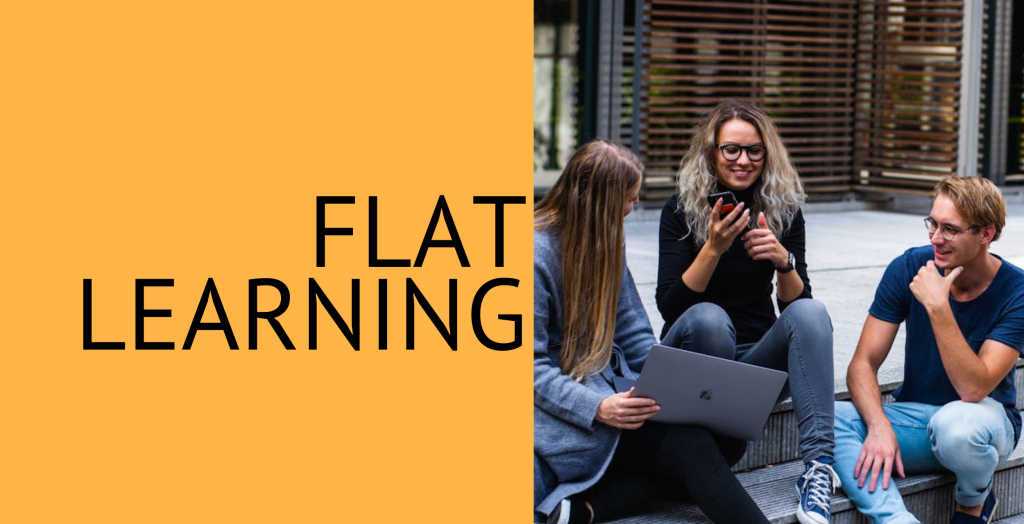Approaches to Learning
Flat Learning
Flat learning implies there is no hierarchy of learning as such. All voices are equal and no one group delivers the information to another group. It implies that learning does not happen in isolation, is social, and requires making authentic and real connections.
“Flat-connected learning is part of a pedagogical approach enabled by online technologies and has parallels with connected learning, but in many ways, it goes beyond just connecting. It uses digital technologies to forge connections and support everyday workflow, communication and collaboration.” (Lindsay, 2016, p. 17).
The challenge with online learning is sustaining connections beyond the face-to-face and virtual synchronous experience. Flat learning is about being able to work with others at a distance (asynchronously) as well as in person, and it involves effective connection, communication and collaboration afforded by appropriate technologies and the development of digital literacy/fluency.
 Being “digitally literate” means acquiring the skills to make and create meaning and select technologies to do so. If you are [digitally] fluent, you can self-select from a range of tools to achieve the same outcome and navigate collaborative spaces effectively and confidently with other people (Spencer, 2020).
Being “digitally literate” means acquiring the skills to make and create meaning and select technologies to do so. If you are [digitally] fluent, you can self-select from a range of tools to achieve the same outcome and navigate collaborative spaces effectively and confidently with other people (Spencer, 2020).
In a HyFlex learning environment, flat learning relies on student choice (when, where and how to learn) with the understanding that whatever mode/method is chosen, the learning experience and outcomes will be equivalent. Flat learning is also enabled by accessibility when design provides for equality of access to all learning materials and all learners.
HyFlex learning and teaching flattens the learning for all because:
- Good teaching is about learning and not content delivery. Therefore, in a social constructivist and connectivist context, learners are connected through different modalities using various technologies
- An individual’s personal learning network (PLN) is key to flat learning and the HyFlex approach. Learning becomes the energy that drives the curriculum. Student agency and autonomy through digital literacy/fluency and knowledge management can make the teacher irrelevant; however, an astute online teacher implementing HyFlex approaches understands this and uses multiple opportunities to connect their students with each other and beyond
- All learning materials and interactions/collaborations are available at all times (choice and access)
“Flat” and connected learning is a multimodal pedagogical approach to learning with and from others where all learners have the freedom to communicate “across” rather than up or down (Lindsay, 2016).
Typical examples of design for flat learning include:
- Minimising closed environments. We know the institutional learning management system (LMS) must be closed to others; however, edtech tools such as Padlet, Voicethread, and others can be set for open viewing or even open access to avoid “blocking” users and to encourage collaboration beyond the immediate cohort and beyond, as required
- Providing a synchronous “backchannel” for hybrid learning where on-campus and online converge. Current practice usually divides these two stakeholder groups while in a synchronous session. This is alienating and not encouraging of collaboration. Typical tools for this include MS Teams chat, Padlet or a learning environment like Zoom or Engageli
- Leveraging collaborative authoring tools such as Google docs and slides
- Selecting and using a class/course hashtag for use with LinkedIn and other social tools that feed interactions and responses
- Encouraging the use of open resources and open sharing among learners
- Designing assessment that can be openly shared, or at least a part of it, such as a reflective blog post
References
Lindsay, J. (2016). The global educator: Leveraging technology for collaborative learning & teaching. International Society for Technology in Education.
Spencer, K. (2020, March 16). What is digital fluency? https://www.digitallearningcollab.com/blog/what-is-digital-fluency
Media Attributions
- Flat Learning © Buro Millennial is licensed under a CC BY (Attribution) license

